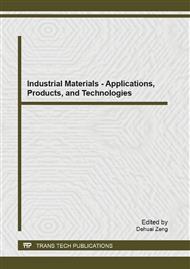[1]
Chander, P. and H. Tulkens, in: A Core-Theoretic Solution for the Design of Cooperative Agreements on Transfrontier Pollution, International Tax and Public Finance, vol. 2(1995), pp.279-293.
DOI: 10.1007/bf00877502
Google Scholar
[2]
Chander, P. and H. Tulkens, in: The Core of an Economy with Multilateral Environmental Externalities, International Journal of Game Theory, vol. 26(1997), pp.379-401.
DOI: 10.1007/bf01263279
Google Scholar
[3]
Germain M., Toint P., Tulkens H. and A. de Zeeuw, in: Transfers to sustain dynamic core-theontroretic cooperation in international stock pollutant control, Journal of Economic Dynamics and Col 28 (2003), pp.79-99.
DOI: 10.1016/s0165-1889(02)00107-0
Google Scholar
[4]
Finus, M., Sáiz, M.E., Hendrix, E.M.T., in: An empirical test of new developments in coalition theory for the design of international environmental agreements, Environment and Development Economics 14 (2009), pp.117-137.
DOI: 10.1017/s1355770x08004634
Google Scholar
[5]
Germain, M., van Ypersele, J. -P., in: Financial transfers to sustain international cooperation in the climate change framework. CLIMNEG Working Paper No. 19, Universite Catholique de Louvain-la-Neuve(1999).
Google Scholar
[6]
Barrett, S., in: Self-Enforcing International Environmental Agreements, Oxford Economic Papers, vol. 46(1994), pp.804-878.
DOI: 10.1093/oep/46.supplement_1.878
Google Scholar
[7]
Eyckmans, J. and M. Finus, in: Coalition Formation in a Global Warming Game: How the Design of Protocols Affects the Success of Environmental Treaty-Making, CLIMNEG Working Papers, No. 56(2003).
DOI: 10.2139/ssrn.981409
Google Scholar
[8]
Eyckmans, J., Finus, M., in: An Empirical Assessment of Measures to Enhance the Success of Global Climate Treaties, CLIMNEG Working Paper No. 61, University of Leuven (K.U.L. ), Belgium(2004).
Google Scholar
[9]
Diamantoudi, E., Sartzetzkis, E., in: Stable international environmental agreements: An analytical approach, Journal of Public Economic Theory 8 (2006), 247-263.
DOI: 10.1111/j.1467-9779.2006.00262.x
Google Scholar
[10]
Barrett, S., in: Dikes v. Windmills: Climate Treaties and Adaptation, in Discussion Paper provided for the workshop: The Environment, Technology and Uncertainty of the Ragnar Frisch Centre for Economic Research, Oslo (2008).
Google Scholar
[11]
Buob,S., and S. Siegenthaler, in: Does Adaptation hinder Self-Enforcing International Environmental Agreements?, Working Paper February 15, (2011).
Google Scholar
[12]
Marrouch, W. and A. Ray Chaudhury, in: International Environmental Agreements in the Presence of Adaptation, Paper presented at the Montreal Workshop in Resources and Environmental Economics, February (2011).
Google Scholar
[13]
Parry, M., Canziani,O., Palutikof, J., van der Linden, P., Hanson, C. in: Impacts, Adaptation and Vulnerability. Contribution of Working Group II to the Fourth Assessment Report of the Intergovernmental Panel on Climate Change. Cambridge University Press(2007).
DOI: 10.2134/jeq2008.0015br
Google Scholar


